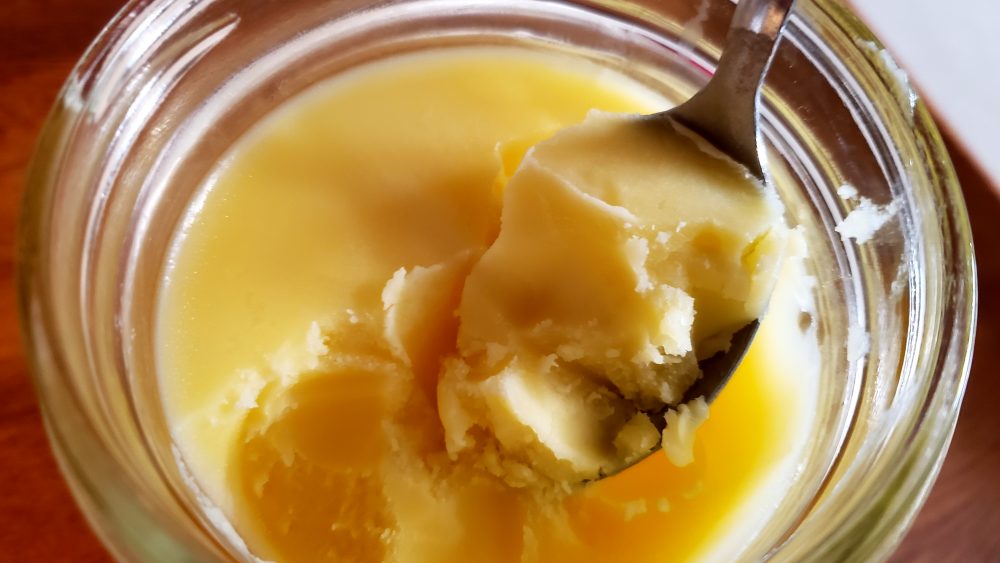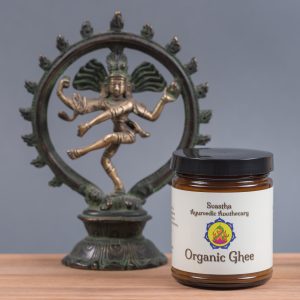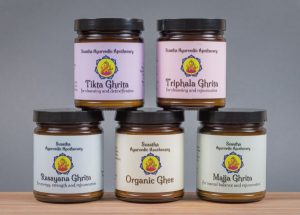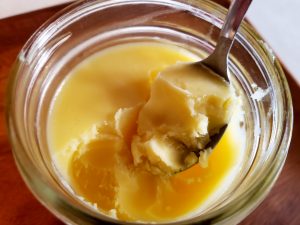 Ghee, sometimes referred to as clarified butter, is an Ayurvedic staple in any kitchen. It is commonly used in cooking as a healthy alternative to oil or butter and added to many dishes to improve their flavor. Although it is a necessity in Ayurvedic cooking, it possesses a long list of healing properties and is equally as essential in Ayurvedic medicine. Ayurveda has been utilizing this golden nectar for thousands of years to aid in digestion, promote detoxification, improve energy levels, lubricate the tissues, and reduce symptoms of depletion.
Ghee, sometimes referred to as clarified butter, is an Ayurvedic staple in any kitchen. It is commonly used in cooking as a healthy alternative to oil or butter and added to many dishes to improve their flavor. Although it is a necessity in Ayurvedic cooking, it possesses a long list of healing properties and is equally as essential in Ayurvedic medicine. Ayurveda has been utilizing this golden nectar for thousands of years to aid in digestion, promote detoxification, improve energy levels, lubricate the tissues, and reduce symptoms of depletion.
What is Ghee?
Ghee is butter that has been cooked in a specific way to remove the milk solids. This process eliminates most of the lactose and casein from the butter, making it much easier to digest, even for those with lactose intolerance. With the removal of milk solids, the butter’s overall properties transform it from a not-so-healthy food into healing medicine.
Although ghee has the consistency of soft butter when it is in cooler temperatures, it will soon become semi-liquid or liquid when exposed to higher temperatures (beginning around 70-75 degrees or so). Ghee has an overall creamy texture, however, there is often a slight gritty quality to it, which is a normal factor that results from the milk solids being removed. Whether your ghee is solid, liquid, creamy, gritty, or a combination of these, the taste and health properties will remain the same.
Without the presence of the milk solids, ghee is said to have an infinite shelf life and will actually improve in medicinal value with age. It does not require refrigeration. On the contrary, it is recommended to keep it at room temperature to avoid adding a stale, cold quality to the ghee.
When handling the ghee, it is important to avoid any contact with liquids or food particles to ensure a long shelf life free of contamination. This means that you should use a clean and dry spoon upon each serving!
What are the health properties of ghee?
One of the most notable benefits of ghee is its ability to make food more digestible when added to it. It reduces the dry and rough quality of any food, lubricates the GI tract, prevents symptoms of indigestion, and promotes better absorption of nutrients. Ghee’s health benefits do not end there, however. Here is a list of some of the most prevalent healing properties that ghee provides for us.
Health Benefits of Ghee
- Increases the digestive fire (Agni)
- Promotes better absorption of nutrients
- Increases Ojas in the system (energy, vitality, immunity)
- Heals and soothes the mucosal membrane of the GI tract
- Beneficial in leaky gut syndrome, IBS, Crohn’s disease, ulcerative colitis, and other inflammatory intestinal disorders
- Promotes healthy elimination, reduces symptoms of constipation
- Lubricates the vital tissues of the body, reduces internal and external dryness
- Promotes the release and removal of deep-rooted toxins (it is often taken in large dosages during a cleanse for this purpose)
- Improves the health of the brain and nervous system
- Reduces overall inflammation
- Increases the potency of herbs when using medicated ghee or taken with an herbal formula
- Reduces Vata and Pitta imbalances
Who is ghee best for?
It is said that ghee is tri-doshic, meaning it is suitable for all three Ayurvedic body types (Vata, Pitta, Kapha). However, generally speaking, ghee is best for Vata and Pitta types and should only be used in moderate amounts for Kapha-predominant individuals.
Discover your dosha type here!
When should you avoid ghee?
Although ghee is very medicinal when used properly, it can just as easily become toxic when used in the improper context. Those with high Kapha disorders such as obesity, high cholesterol, and congestion or with heavy toxins should avoid ghee until balance is found. Otherwise, ghee can be enjoyed daily, making sure not to exceed 1 teaspoon per meal* unless advised differently by a knowledgeable Ayurvedic practitioner.
*During times of cleansing, a larger amount of ghee is often prescribed for short-term use.
How can I use ghee in cooking?
Ghee can be used in cooking to replace oil or butter in virtually any recipe (stir-fries, soups, stews, dal, kitchari, steamed or sautéed veggies, cookies, cakes, pastries, toast, oatmeal, etc). This not only gives delicious flavor to the food but enhances the digestibility of the meal and promotes the absorption of its nutrients.
Alternatively, you can add a small spoonful of ghee (per serving) after the food is cooked. For example, after serving a bowl of kitchari, add in 1 teaspoon of ghee and stir well until melted. Add some flavor to your steamed veggies by melting a little ghee over them and adding a dash of mineral salt (yum!). Ghee will undoubtedly enhance the flavor of any meal!
How can I use ghee as medicine?
Ghee is often prescribed to be taken simultaneously with an herbal formula, especially when addressing Vata disorders, mental imbalances, nervous system disorders, depletion, low Ojas, and other similar imbalances. The addition of ghee to the formula will enhance the potency and absorbency of the herbs, making them more effective. When used in this context, it is often taken as 1/2-1 teaspoon of ghee melted and blended with the prescribed dosage of the powdered herbal formula.
Another method of using ghee as medicine is the infamous medicated ghee. This is ghee that has been slowly infused using a traditional Ayurvedic method that allows the ghee to take on the essence of the respective herbs. This is a very powerful way to take an herb or an herbal formula and is often much more effective than taking the same herbs in powder or pill form.
Finally, you can take ghee on its own to allow the healing properties to penetrate deeper. This is seen when taking ghee mixed with honey to enhance energy, rejuvenation, and libido, or when ghee is melted and taken in large dosages during an Ayurvedic cleanses such as Panchakarma (traditionally this can be up to 1/2-1 cup of ghee at a time, oh my!) and kitchari cleanses.
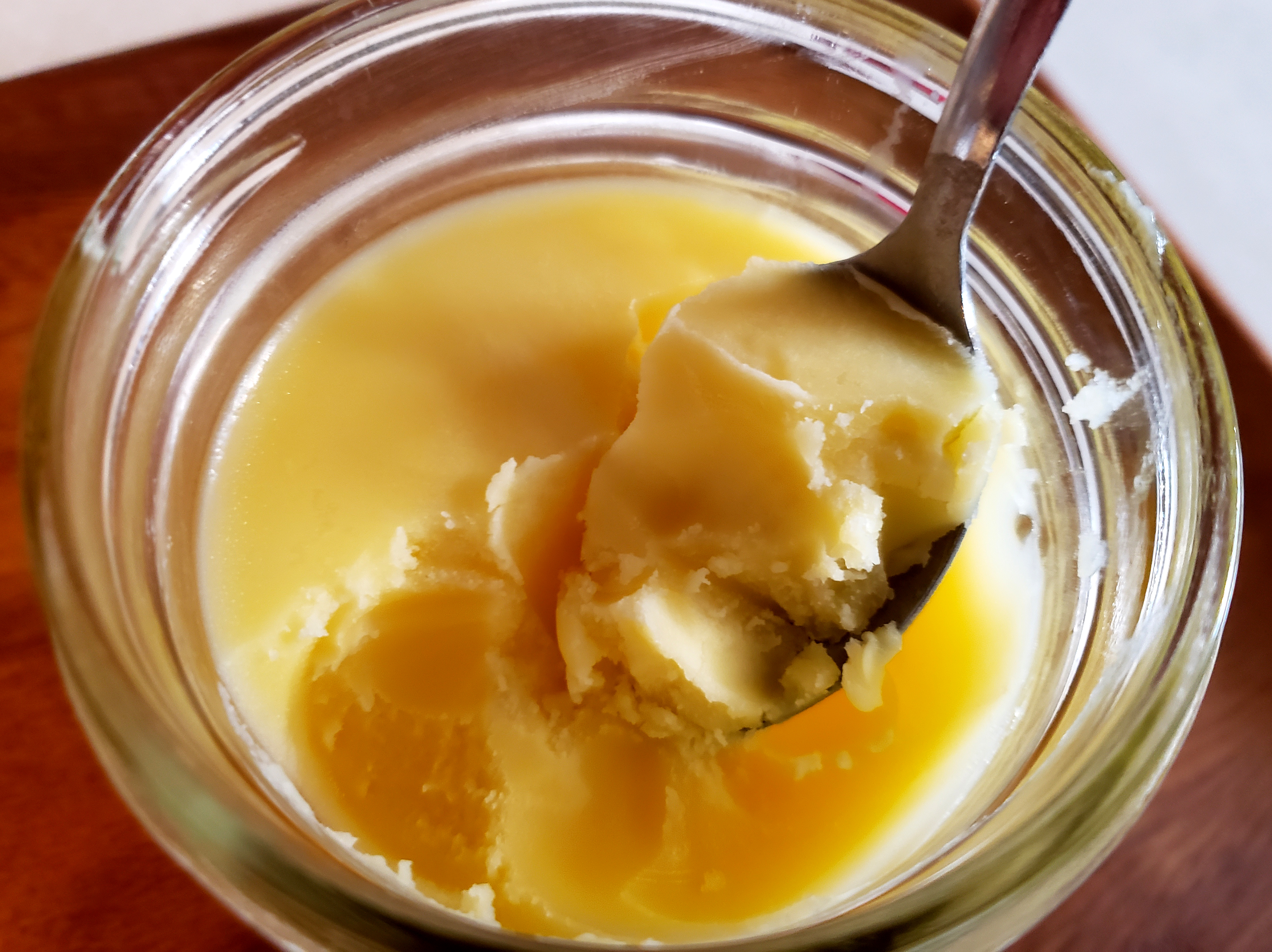
How to Make Ghee
Click here for a printable copy of this recipe.
*Ghee is considered tridoshic, however, it will increase Kapha in excess. Those with a strong Kapha disorder (e.g. obesity, excessive weight, high cholesterol) should avoid ghee until balance has been found.
Materials
- Medium-sized pot (make sure it is completely clean and dry)
- Cheesecloth, thick paper towel, or thin (clean) dish cloth
- Small mesh strainer (when using a paper towel or dish cloth)
- Clean and dry glass pint jar or similar glass container for storage
Ingredients
- 1 pound unsalted, organic butter (traditionally, cultured butter is used)
Click here for a printable copy of this recipe.
Directions
1. Unravel the 4 sticks of butter and place them in a medium sauce pan over medium heat to begin.
2. Stir the butter occasionally until all the sticks have melted completely. Once this has happened, reduce the heat to low.
3. Let the melted butter sit uncovered on low for about 20-30 minutes altogether. During this time, you will notice a frothy white foam that will begin to form at the top. This is the milk solids separating from the oil and can be removed with a clean, dry spoon periodically.
4. Since each batch may vary in time, it is very important to begin to watch the ghee closely after 20 minutes. You will notice the cloudiness of the original butter will begin to slowly disappear until you are able to see through it like an oil. The white foam will begin to settle at the bottom of the pan. Once the ghee is completely transparent and the curds at the bottom begin to brown ever so slightly, remove the ghee from the heat. If left on even a minute too long, the sensitive ghee may burn and become unusable.
5. Once finished, let the ghee cool off for about 15-20 minutes. Strain the finished ghee into a clean and dry glass container using the cheese cloth. Make sure the milk solids strain out completely. If you are using a thick paper towel or a thin dishcloth, you can use this method by placing a small mesh strainer over the glass container and then placing the towel over the strainer.
NOTE: If needed, you can use a thick paper towel or thin (clean) dish cloth to strain by placing a small mesh strainer over the glass container and then placing the towel over the strainer.
6. You will be left with a beautiful, golden, transparent oil that will eventually solidify once it cools to room temperature (unless it is hot out, then it will stay liquid or semi-liquid).
Storage tip: Ghee has an infinite shelf life and does not require refrigeration. Make sure to use clean, dry utensils with each use since ghee is susceptible to mold when it is mixed with even small amounts of food or water.
Check out some additional tips underneath the pictures!
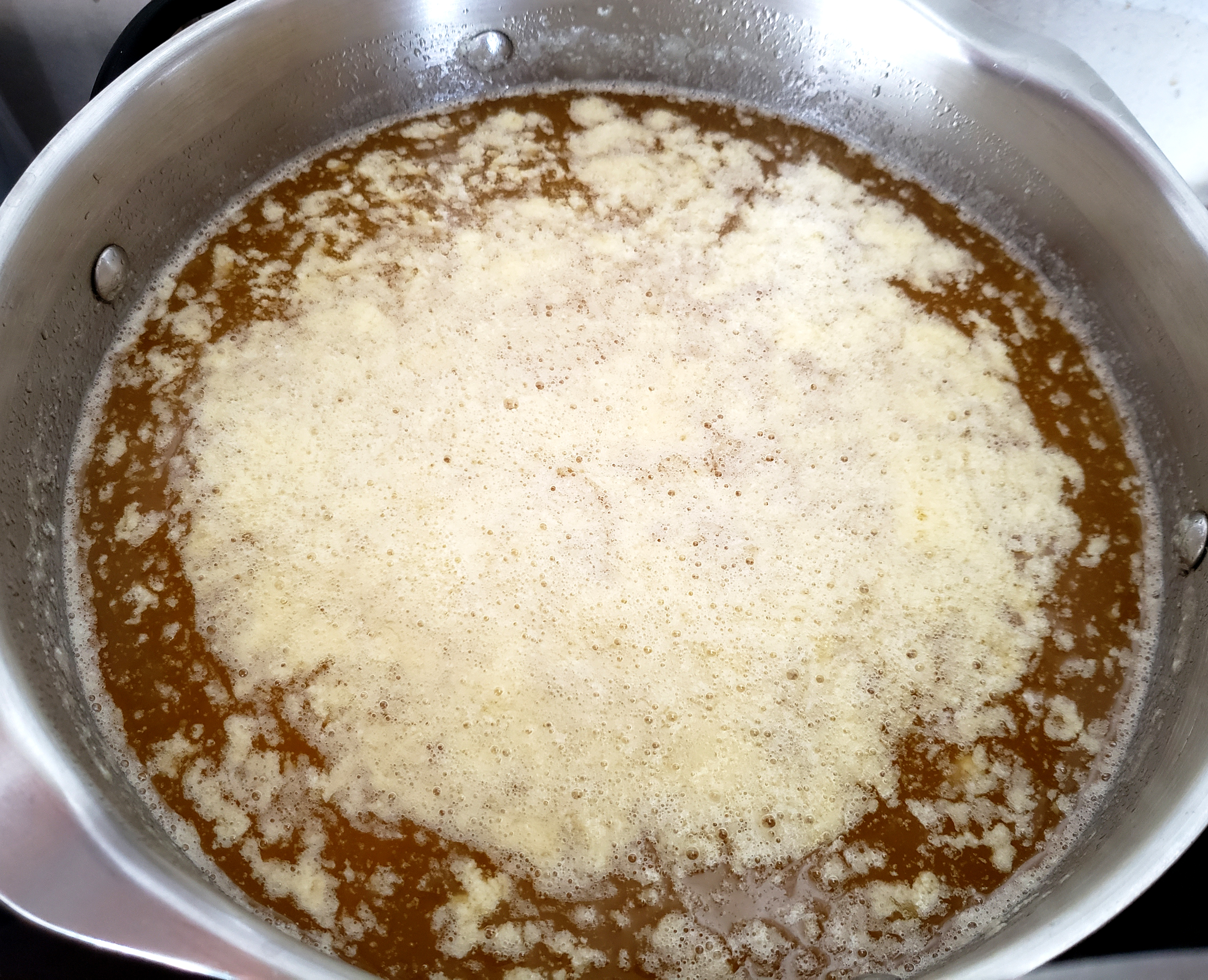
The milk solids will rise as you begin to cook the ghee.
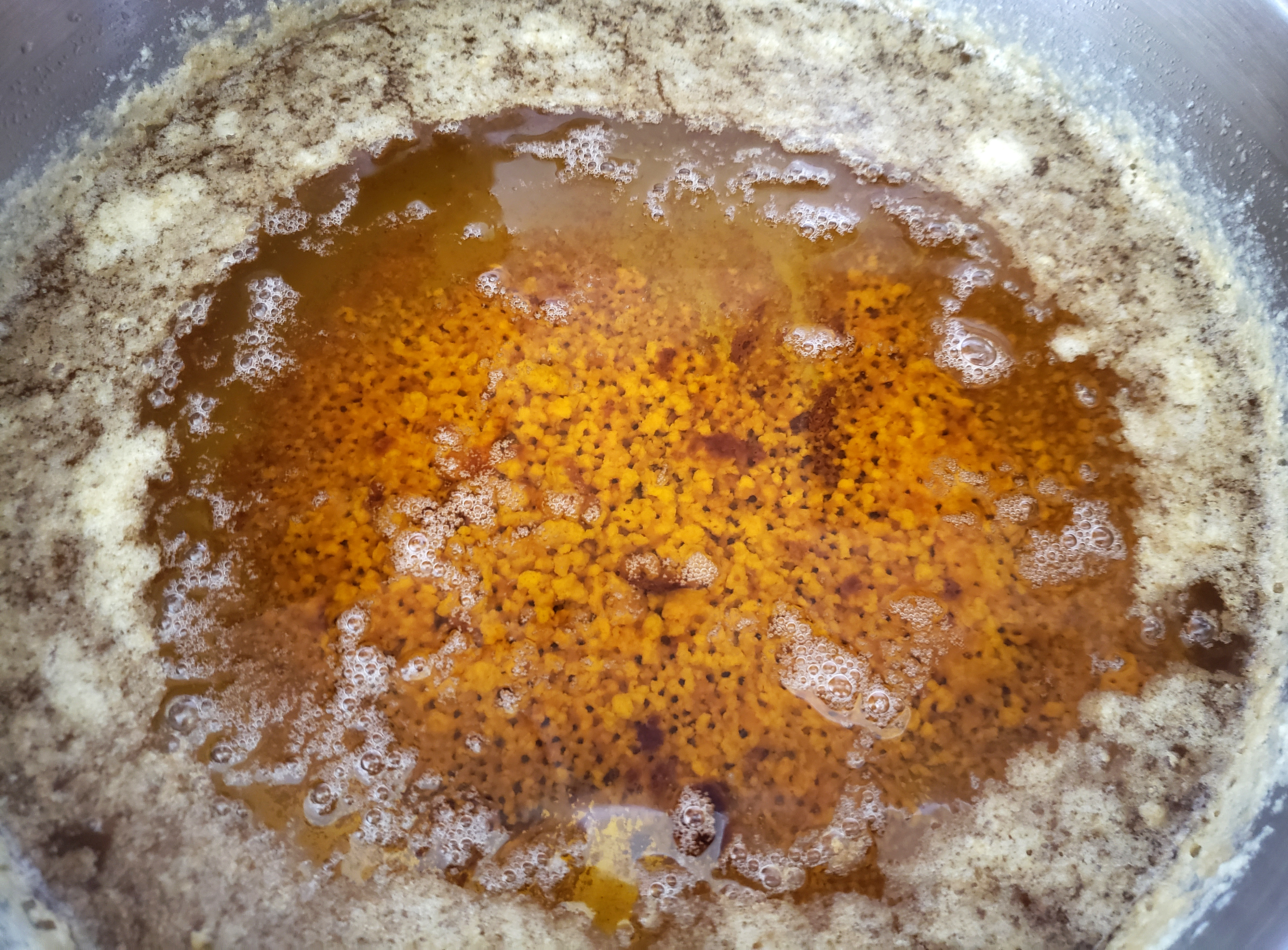
The ghee becomes translucent once it is complete, and the sunken milk solids will begin to brown at the bottom of the pan.
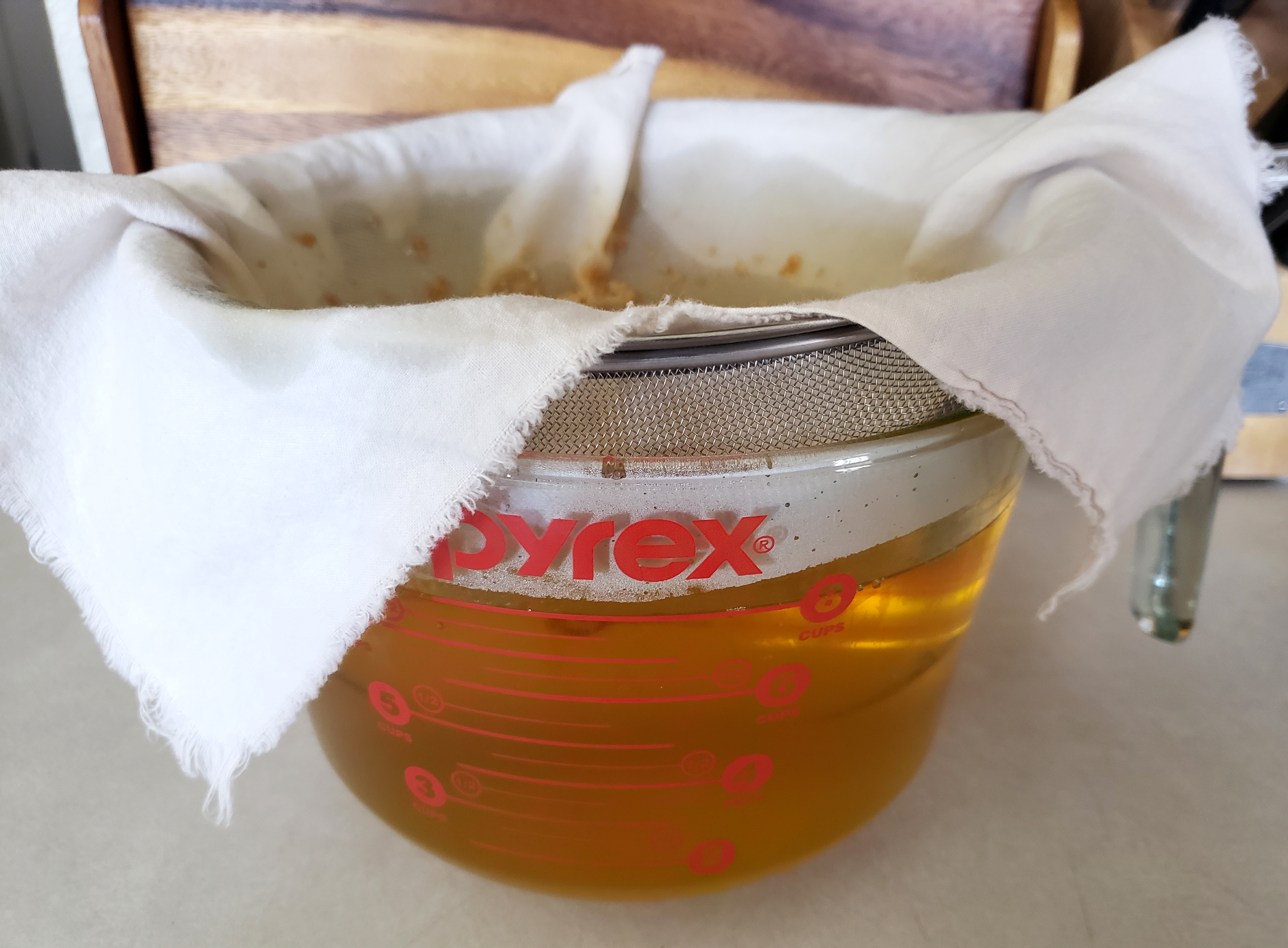
Once complete, strain the ghee into a glass container using a small mesh strainer and a thin cloth.
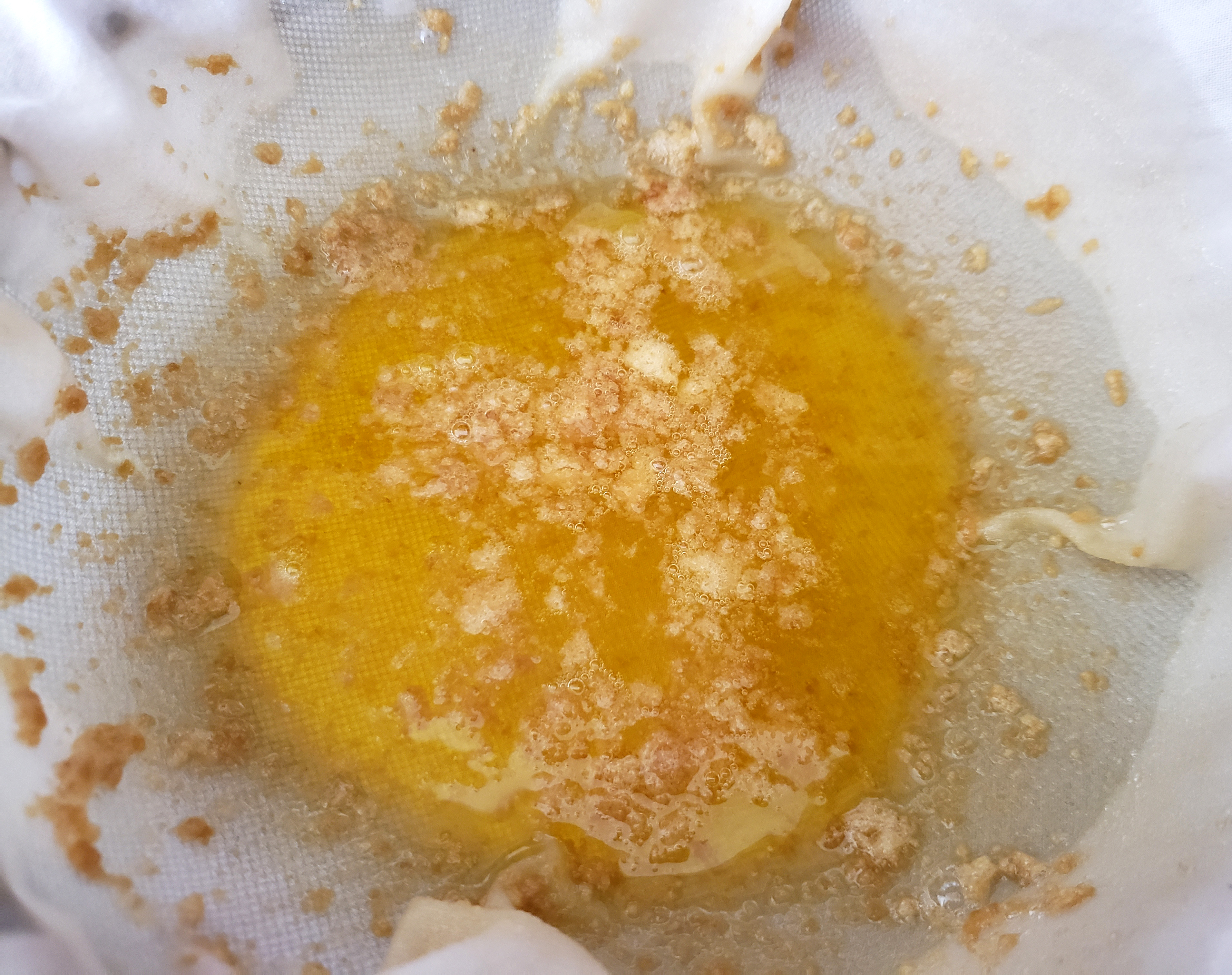
Make sure the milk solids are completely removed to avoid the ghee contaminating in the future.

Add the strained ghee into a clean pint-size glass jar. Once the ghee cools, you will have a beautiful, delicious golden ghee to enjoy!
Additional Tips
- Ghee can be kept at room temperature for an infinite amount of time as long it does not come in contact with water, food particles or other contaminants. Refrigeration is discouraged as it adds a cold, stale quality to the ghee.
- Ghee may become liquid or semi-liquid at warmer temperatures (about 70-75 degrees or higher); this will not distort the taste nor the health properties of the ghee.
- Never eat an equal amount of ghee and honey by WEIGHT (not volume) at the same time. This is considered an improper food combination and toxic to the system, according to the ancient Ayurvedic texts.
- Avoid taking in more than 3 tsp of ghee daily (1 tsp per meal). Taking in more than this on a regular basis may result in high cholesterol, weight gain, toxins, or other Kapha disorders.
- The milk solids are said to possess their own medicinal value. Feel free to save them and add a small amount to any recipe. I personally used to give a small spoonful to each of my dog’s meals; needless to say, he was a happy dog!
- To add even more nourishing qualities to your homemade ghee, try making it on a full moon day (or night). Since ghee and lunar energy have similar qualities, the ghee becomes even more healing. Reciting a mantra while cooking is another auspicious way to enhance the healing properties of your ghee.
Try our Organic, Grassfed Ghee!

